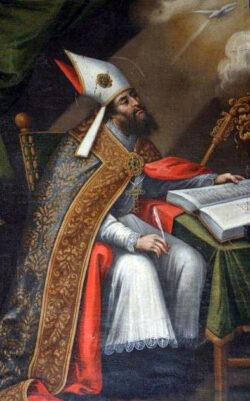Saint Jerome is a famous Saint. But who was he? What is the Vulgate? and after all… Was St Jerome an ill tempered individual?
Newsdesk (09/10/2022 6:20 PM, Gaudium Press) The present does not always judge the past fairly. When we look back over the centuries which preceded us to evaluate a personage, an institution, a fact or a situation, very different movements can assail us: sometimes we act with indulgence, sometimes with rigour.
If it is true that time heals all wounds, it is also true that the clock of centuries makes us forget the faults of others and cool our tempers. It is easier to forgive an offence the day after the argument than in the heat of the quarrel.
However, time also feeds grudges and sometimes a reply patiently waits for decades. ‘Revenge is a dish that is best served cold’… Woe betide man!
Time can, therefore, alter the truth about the past, when we cast different lights on these facts: indulgence, rigour, admiration, envy, love, hate, indifference.
And when the present analyzes the characters of old, these same feelings may act. In this case – assessing ancient men – the errors will be even greater, because we are often led to judge them out of their historical context, with our contemporary eyes, with our contemporary faults.
Therefore, is the study of history relative? No. But it cannot be done by superficial spirits.
Let us look a little at the history of Saint Jerome. One often hears here, there and everywhere severe criticism against St Jerome. They attack his temperament, his work and his legacy. Is this judgment fair?
Biography of St. Jerome
“Jerome, son of Eusebius, was born in the city of Stridum, which was afterwards destroyed by the Goths, and which was once on the borders of Dalmatia and Pannonia.”
It is difficult to rewrite the life of the men of the first centuries of Christianity. We are in other times, when birth records are still far from existing. In the case of St Jerome, however, he has left us many clues, for he wrote a short autobiography in his book De Viris Illustribus.
The saint probably came into the world around the year 347, and he himself implies that he came from a Christian family, for he says that he was “fed on Catholic milk”.
We have almost nothing about his childhood.
Persecution and Baptism
However, the persecution of Julian in 362 gave Jerome the occasion to manifest his temperament and his Faith.
In those days, Baptism was not administered to children, but the custom was to confer it only on adults. Now, when the emperor’s laws began to close a circle around Catholics, and pagan rites came back into the light, Jerome, who was studying in Rome at the time, asked to be bathed in the regenerating waters. A courageous, defiant and sublime gesture.
The edict of Julian initially forbade Catholics to teach. It was only later that violent persecutions were unleashed. By asking to be baptized, Jerome was putting his career at risk, and later his life.
Fortunately, the Julian scourge was short-lived, for in 363 the emperor died on the battlefield against the Persians.
Monk and secretary to the Pope
The contemplative life attracted St Jerome. After a religious experience with some friends, our Saint set off for the deserts of Syria to live with the anchorites.
It was during this period that Jerome began to manifest his rare gift for learning languages. Latin, Greek, Celtic, Hebrew, Aramaic… No language posed a problem for him, and in a short time he assimilated them as if he had learned them from the cradle.
He travelled in the East, to Jerusalem, Antioch – where he was ordained – and Constantinople. He knew more and studied more. His passion was the Holy Scriptures.
In 382 he was again in Rome, at the side of Pope Damasus. The pontiff, admiring Jerome’s gifts, entrusted him with a titanic task: to prepare a Latin version of the Bible. This was to be his life’s work.
Next to the grotto of the Nativity
When Saint Damasus died, Jerome settled in Bethlehem, where he founded a monastery. He remained there until the end of his days, when he was already over 70 years old.
His work is vast. Besides the Vulgate (which we will treat next), St. Jerome has countless exegetical commentaries, several spiritual texts, a monumental portfolio and… a lot of doctrinal polemics.
He is one of the four “Doctors of the Latin Church”, patron saint of translators and exegetes.
The Vulgate
Catholic Doctrine is solidly based on the Holy Scriptures. The Old Testament points to Our Lord, and the New tells us what the Incarnate God was like and what He taught.
Now the gospels and the letters of the apostles were written in Greek, for this was the common language in the East. The Old Testament also had a Hellenistic version, called the Septuagint.
However, if Greek is a foreign language to us, at that time it was the English of the 21st century. After Rome had annexed Greece, the sons of the she-wolf became bilingual. The language of Virgil and that of Homer were spoken equally, on the Capitol, on the Palatine, as in all Urbs. Thus, in the first centuries of our era, the diffusion of the Sacred Scriptures took place without difficulty.
In the fourth century, however, the situation was not the same. After Constantine there was a gradual separation of East and West; Greek was no longer common. And so that the sacred books could be understood, Latin translations began to appear all over the empire.
Variety undermines unity. And in matters of doctrine, there should only be unity, because Truth is not multiform. If the Truth is disguised or altered, it becomes deformed and misleading.
Saint Damasus understood the danger and entrusted Saint Jerome with a Latin version of the Holy Scriptures.
However, the Pope first wanted to assess the qualities of his secretary.
Defending the Virginity of Mary
About these years a certain Helvidius of Milan, an Arian, wrote a work attacking the perpetual virginity of Mary. He said that, according to the Scriptures, it is evident that Our Lady had other children after Jesus. He claims for this that the gospel alludes several times to the “brothers of Jesus,” and in St. Luke Our Lord is called the “Firstborn.”
St. Jerome knew not only the Hebrew and Greek languages, but also the customs of these peoples. Now, to understand Sacred History thoroughly, it is necessary to understand how the ancients thought. Saint Jerome defended the virginity of Mary with ardour:
“Every only son is firstborn. Every firstborn is not an only child. One is firstborn not precisely because others come after him, but because no one has preceded him” (Contra Helvidius, 12).
With regard to the “brothers of the Lord”, he explained that in Judea, as well as throughout the Mediterranean basin, it was customary to use the word “brothers” to designate all male relatives of the same generation, or of close age, as cousins, for example. The Gospel makes it clear that they are not the uterine “brothers” of Jesus, because it never designates them as “sons of Mary”.
Some commentators said that St Joseph had children in a marriage prior to Mary’s. The “brothers of the Lord” would then be half-brothers of Jesus. St. Jerome – he is the first to refute this! – claimed that this could not be so, for St Joseph was young when he espoused Our Lady and, like her, had taken a vow of virginity for life.
Translation from the original language
St Jerome’s great desire was to translate the Holy Scriptures on the basis of the text in the original language. Therefore, besides revising and correcting the existing translations, he wanted to take Hebrew texts to make his version.
This was not always easy.
When St Jerome translated the book of Tobit, he was already living in Bethlehem. To obtain a basic text, he got a Jew who guarded the synagogue to lend him the book at night, so that the other Israelites would not know about it. The result: Saint Jerome translated the whole story of Tobias and the Archangel Raphael in ONE NIGHT!
The work of Saint Jerome was colossal. The Vulgate, that is, “the common version”, “the people’s version” was made official and lasted for 16 centuries.
Criticism of St. Jerome
I once heard that in a certain European monastery, the religious were indignant with Saint Jerome when his letters were read during monastic meals. According to them, the holy doctor was very violent and irascible. This happened at the beginning of the last century.
Those who read the correspondence of Saint Jerome and his exegetical commentaries may at times not understand some of his attitudes. Not understanding, we run the risk of judging him with our contemporary criteria. And in judging others, we are always inflexible.
Saint Jerome lived in an age quite different from ours. The Church, fresh out of the catacombs, already had to face another struggle: heresies. It now needed to nuance its beliefs, define its dogmas, purge errors. One generation was not enough for this task, on the contrary, centuries were needed, during which councils followed council discussions, holy doctors followed heretics, imprecise doctrine followed clear definitions…
In short, for this it was necessary that men of the stature of Saint Jerome should fight. And they fought courageously. It was not uncommon for wise figures, like Origen or Tertullian, to slip and suddenly collapse under the weight of error. And so those who held the truth, inspired by the Holy Spirit, needed to be inflexible, uncompromising and sometimes violent.
Truth is like water. It is salutary only if it is pure. If someone spills imperceptible drops of poison into this precious liquid, even if it dissolves in the crystalline volume, the whole becomes evil and deadly.
St. Jerome understood all this. And this man, who is sometimes called the “Translator of God”, wanted the Catholic Faith to remain clear, pure and wholesome.
By Paulo da Cruz


































